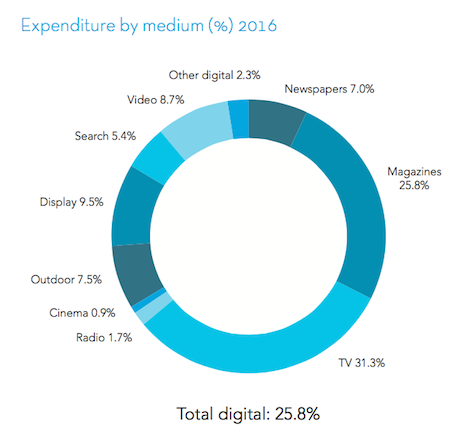Digital luxury ad spend will finally overtake print advertising in 2018 among a host of other changes to the luxury advertising landscape.
This data comes from Zenith, whose report on luxury advertising expenditure predicts among other things that display advertising will lose its lead in the near future in favor ecommerce advertising instead. The report represents a good look at how luxury ad spend is changing and what consumers can do about it to stay ahead of the curve.
"Print is still the primary medium, a 32.6 percent share of total expenditure in 2016, ahead of television and digital," said Jonathan Barnard, head of forecasting at Zenith, London. "However, digital is gaining ground and should become the leading medium by 2018 with a 30.9 percent share of the market.
"Digital should account for 87 percent of total ad spend growth between 2016 and 2018," he said.
Print vs. digital
At the moment, print media is still the dominant advertising format in the luxury industry. It has been for years and it is still coasting on the legacy of legendary luxury publications such as Vogue.
But that all will change in the next few years as luxury ad spend shifts more to digital, eclipsing print for the first time.
Zenith looked at advertising spend trends from a number of luxury brands around the world and published the results in its "Luxury Advertising Expenditure Forecasts 2017" report.

Last year print was dominant but not by much
In addition to predictions on digital overtaking media, the report predicts that the general luxury industry will see ad spend growing over the next year, in response to it taking a hit last year.
Concerns about terrorism, currency fluctuation, geopolitical tensions and emerging nationalist political parties have made international luxury spenders less confident, but that will change in 2017.
"The United Kingdom is reportedly the cheapest market in the world to buy luxury goods following the drop of the British pound," Zenith's Mr. Barnard said. "The U.K. has experienced a dramatic rise in ‘luxury tourism’ as a result of this.
"Given that international clientele account for 50 percent of the sales of some luxury brands, this has provided a strong boost over the past quarter," he said. "However, this may be a temporary boost as luxury brands scramble to adjust their prices and time eases tourists’ nervousness about traveling to mainland Europe."
Overwhelming options
There are a number of reasons that luxury brands are shifting towards digital advertising, not the least of which is its lower cost than print.
When done right, digital marketing can generate a cost-per-acquisition (CPA) at a far lower rate than offline advertising (see story).
Outside of luxury specifically, digital advertising has shown amazing growth for all industries.

Next year, digital will take the lead
As brands looked to leverage media events, television remains the top channel overall, with a 41 percent share. However, its 2.3 percent expected growth in 2017 pales in comparison to digital’s 13.6 percent (see story).
Most of all, the thing brands will have to deal with when it comes to digital advertising is what to do with all the options available to them.
"Over the next few years the biggest challenge will be taking advantage of all the new opportunities offered by digital advertising – such as targeting, personalization, branded content and optimized ecommerce – while maintaining their brands’ image of exclusivity, and ensuring that communication with consumers always takes place in high-quality environments, giving them a true luxury experience," Zenith's Mr. Barnard said.
{"ct":"75lCnsPldVQMz2rAGgGRKjDztOtZiXpJpwnvANayzEwDkjCfLquII+aqLTksav6bEiWDDf9sZ8bTgeG0eDEcgUhWzBZopDrJOcne2t0EhNb5axY4gTaaTtu9+lYMdKe\/ykdDaqiIOGNAOrr0LJmtcVlIpT8XEqnUlY3HH6B08TBzfMcHBD78m2Jrr31wGZfnr2AVyxpx0dGbZv6THchbdf+\/narp0v105khJgkmRpSkFBxNfFlrrRbhZJ6Pn2q1nrfoccyKCwCb02qStepy1ugFUqkPxjWPiZKaX37NOm6VuuEIaUeN2azZAzk3IPpwudArCUzgXvPnxIA4Yj8X9ee8eO0U7fag80y3jCXq\/SmeOJWfynuLlMht\/dBticCZMUhvovP23DHdLFky5dXaNYhABW\/TPwW4VlxWPHKyYxT78kEXKhbI\/5cBkZNk4KYBNVUo9d3a0q9Pq8qBc3n7mhYeHIGUeJc5kRHKJrzvLWXHKWf0\/MCahNoXKOVtIErFb7CwIVH+8H\/vLe\/\/tBHbDNib8JUKM3nldIvV46LHYyjTOZP7wKprJd7aUuLRMKBZLST2QFsEnyCQmD+qZ6MfiEk4m9dNitgW9RH3vpzrkADO2j2Gt\/ZFN+tZ5OD19jq3cUD6rugwBvmwd32vQyEhtfIo2f7CwPsHAmIciW5j3IxEI23uSoBPk5ssJSUqTKfnkE9SGlLYuBrB0CWme8N1QIFQ++9qDeD2eOk\/Asn6lYrkJ0cbpklmbPvsVcUzaiHiBh+n+vr7pDLKH+QV6QV3isKlvEIzrYzJAKASfehU7NkUsFsn3+0hJFn2m2gderygDi0RQ5L+Bn+5vM97QC6twNhyM7+X3pC52WkxNLVq3sPJ20R0d3CihM+6DFpwPFVzIVWf4UMmysqm+lV\/XOIQJlcnI83+JUu8a+\/ntK7BL68fojY0qytKdB5tX0nvFROJ33YuqECOqRo58R\/j5NFuVHFPeiJ+fJNP+wGoZAs69rWXO1hskTWn\/WrnQQ\/oRzmy1sXO069HCl+hmdRFsoirGFIJUmYUl5bH7v7kEDk1A+pEe5KlCgKRjD4lvjiIZjP55xhZy2S9EjSAB\/3aRdAxzHVeQymp4iMoj5YKAfFEZ5hrGNqQbIUxppUUvfHhyOU00UNnP6dWarApU7ZwKes4IqNuXGgsD+kJR7D0ucui9mthrYG3GHJYA6v4njxMdmo72dpx\/XizHhASs\/OzLNFPcaiWOWHZFvqc+PjjCWoRDybrQvLP42gZ5kq\/SubNQEbaOQLmGjjMIyF90ZsNu9vdHu97iHfWs4otJq5szR6e2qfeZKYH80\/Izpwn23dXy0LYXA91TrAzH7Oz5Ahi+Dpm7YsE+8JssQ\/CoDQsl7GnO84SOFyi7C7ObnIB2C\/7Uw0MXrM\/Mt+YViykIqHPPh2srgBv8po72Or1JfybTJOM3lVpcfK\/q9eQQjvS1LtCbJ4UKVK+8UeYUCAv45\/ZMNcWDb5tAVEbR5z4V72RfJD48zyoBedTxJrNXCrXsFwGhO3rfQHybL0+m7oipHkJrAwIV90jrBQLiaZoW7CynX91mA0C3GJ7+I6xXUXVbGrbskyzURQeo92NHJ5NY8IxUwlcIXY8FwHPASNNLAxBLp1EPFf2JjDdkpcnQceT5ya3qxNQtGXge0zXXDc+iqlQW4mEFy5sreaj6V9yGdX4Gah8fV6QscWac2Rm2ZwjInM\/ZxaQE0m1PmfxRUfyKoOk1Dr7ndk7Qk1XCSvtDEj+VkxDX\/\/YSohTdC28lKMrFFHxHxgQnaDbR6yrpftFuyN4CIVmVdi2kTMH8SG2SSUQs53jdTA5b+B4oALeaRD4W8uUMKJHCpA4lQOeh7EueHYnmaycHqY4QB06Lmxm66KKT4DUVIEYVBP4QbHHXTN+OETSwfvxBwCcIx101kEP750HQxqvWPoeUJph5ps+Wv22kqSYubykXUO4CVUwf8FFRgyEQp0aUboj5e0iHjXr5zgmQTyPOCTQohZT5iVLCDnCf7rhja\/C\/Q7jo6pIZtZ\/gEd421vMLEHHWzlOqw70FQ8XFBE8l11X5nM3WNQ0gCNcwKejBGzlL7vKnIGPLSMyZ5sYqFK9fJ3ekPThK2z+kXcNz47znb1SED9qCWhQCwawoKbyyxexrT3WPjwZJxwEtkUjL\/LNmCSts2GEbqo3zo+6Jp8Jri4ssoOOAT6ju9cI7lbkOzQWKdQCYJ1CbT4xp7Spcr2ExSpZA5IyQvjgc2tp3oeX\/Owqp7PwmFVC6kYyJR+5NyT+lsV+HUymsrk1eQkeb9Ho\/3Y208XKXoMofZLUiFPf3WIB0f+WfNgGHEFCDZDkx1E+6GoZ2V3bYx7ZC\/QOCVgqNjwSSkRzqnYbe5wWmdgMDAygAEiQ2u3jAe7pq3WQFG+0aqipolioGNRbQKzle7DMpw1M9NwoJqnb8dpRM+m2otIuGBtEWpsC8ewk5GYjEcHV\/N9y0kNedKzcAEqJWZ3rrGyaqTGoE0XtycO9\/00qYotgYa+7X5dQoiAtcdqEkYSySfqZ+5ZuGVVcN1r0DZTWWp29aDSnT1S\/X8EjPMejNgj45Mq96CC2fLXNAYiwfx3iNU2IR69TWMiTLFX\/Db6ckQO50L6QDG6ERrS3ZPtAq1YpptteIrlj30\/c8vYidH0BBLc0q8AnvQOZ89nzbhNhMQLTMV342cAzHhNVWwEBNg6CfG3TitHvxMOHt7IH0+AoB6yiyIQyTZSfEdNbuv04ukcCCRss7x8gkq+dNL0zW3\/O6KsyBBsi7D4leqjvikYag1bWKmhGLH7IpB3oCyy\/tYQrKDpxpUGq7Y6WIM0EeCZGvdhHiqEV9lTkmcb7U22ladS3\/h+SfpZGezlZeyGLMCIFQi9rxZ9nOHnESLiUq929ssvzjhDtC2Z+kJAXNopBmlUP5zBWlFi6M9C82c+I5GZavzmiAWLAcflsaF5oWuln6g\/jjVvOp3y\/TKMbz0C52MdKqg9TqohfYF84oyr7KK6Vn4zIUuRArO9y5c9kjZgE2Tg5wEe3Y+pCJLfYIoXDn2IdG9mC+PH8uLoLn7w+3ITc1+rTgVSFDmw1Un3Ar0vOm7IG6wJ5+mmVWx0f\/dDh3SJ334P92ooXuJrUXxjW3RLZNMVKY0f+VLMmgKGhc+dz8M9qPcEsPGrCe89qSfxe5KV11j2G3RiOBEk612p0rBelrNqRFw1cl8A1ae\/LA7Lt5J9n3CLx7C79GED2DESm6R7RGbea0z7Q9N3Fat5y7dWQIOATT4yAGsPSuEfrczp40fAsOTSWGpnm\/mqE646NWhPyZA+AfGVchEi8rDclXqN6QAYduwkuNuGwt79hondcZdf7dqIjnpERJ3Rio+zJzfmXI8SFzX\/R1MK\/RQ2\/\/e2eGycKWydJUb2G+VFCmLw9t6+bAOthWAzkUrmjhwMndX4KgGYQGl3gKrTB7y\/wloYSsN0a8UKe2YMGjfcTKh52ZGxnd7fnyhc4Y9UjMoH4O4VQBpF6VsjdUQCCIOQx2M3zYa0pap4\/MuNQNLTJFikUV9d7MrQWvQiSqHroFJFViCt06dWEBceP2c4jod6aPf97B5Q3ziuV1n60gh0eO\/9ksM4UzMV0GnU4DcR00vVVZS6uwcSC0MVpLXgJEfpFa6Op2dW78DGxbqFpzAexY9t+sKsjlI+B5RtJqDlCHO7Yw+N6k0oM9scuSBTGyvisqjgMSXRA8if6cIVAVJVUYrJNtn\/18uGh1egxKrvVUcpdumTXkkdeMVYweNdUuK3ws2KbHRyRw2MlfamWx\/aEVCdq97aqTFtM+dtRXJODhp+A\/0SGoYys2gUwDoiZkeYM+u+o8OnW9lGzCwyo4tk9ZkJicoogb83hTYyKDhscYou2ljEo5T8Fkk4PpIDggXl7aswcudYXTmz85s8USycB1DmDJsqQFaXrskD\/oZtLi90cQf+uFFOQmghnBIuA4BFMBghQgaAaF8yZNAJ7ZDBCxhnyes5o43jouh1zGUk2Ibi2ggL14M6ZPW+Vfiyxeu7rbgLej+NTXsp+OcU8Hp0tmmNhlHETXOuZUmJoep9zgy5RffQdGKceZ0q5CXGZ3v72rtxG3neqD1waZmXuXRgEeK9uPKXb8KEfl9N6sf2Kf0XvOUbj3pgYv9MFWRwwLRym0npokCuwRgpWpkOHMxxfOluXsPgGf1rt8B9A8OZfV3mT10wfg37N+IxomO6rT61Jfy4jRk5XICejdhTiImf2OWrrXhxQJyPQ8YFL96JHTBBFePSeSS4nrRxhkzPz6CHJ4wjKuxMZH4sPuhWy7luKn9PVfKRvH5htyqDaAqxDT58bXtIqsCN7UrXrIorjIiTcB46jpbOPrKzbvj7s4\/aPiY5XwaF4bo6U1zlJUAw7xHfCtA9EQnqYD2wqYAjMrrIvDQ08EDiWWMeCWB5nU8xa\/q+eBU7FPRfk5VcueM31jG+E709hNLaPlHVa8hHWVx5tv3ZWcJQqVsemLH6orBwQdwgtQk0b7pHXbYyQd8BFhNNjTHyel7NJD+rhT4nfEijyULbgpMnofTD1\/tE9swyI52\/lrcY\/7ne9zsx6AYNeXig5S17QPPOYHsyA\/iJZ2XTJ6d03mvxEs7zcn9mObZmp6Zyk6pYoGUkfBCcLYSRJUGb91TX30z4mMYXB7VJFd0Ho3CGc0oCYkFXjxGxyQeP\/9kimjcZH2CT54XOmeeHxMbEN5HlAf5p4OyLX0xH9q\/mugqdllXQifwke30YtaeIZE+K7hWtsB\/qjrtRwJmAQIDWgVo0pq42GTGzCosCodxR3nLu26OXx5k4FWDc0w5\/uqi4i9OEVG+DWWkGHBjz3FkLNKTbP7EAlM54127qG\/rCNvXAmBCQaEeoC24pwTNCOCzTCRci8VY1FU20Ymv4cjj8+ciN5pCFXh+DMwdz5o7l5xUea3dAJ2XsexfnwfsUYUOr3pwYljx1cbhfDyjf3WXJCRbmcRJ6Jppn3HzGZff11MQukRUplknLqSbcm3KQulHD+Z8ocLBcKV9gZUP2sKa\/3lpkKMHmejGa5UNd4eTdY\/FZDI2UX7D28DUbXVtSXuobjgOmLfD\/vk1yVpUjg07bXAujomqJD2P\/M4wDghkoIpyaQGkGhi5cLo5iIteJDvLK37uxw\/erGPmJeMltDXogPscPDMhFsE85GU9Ylbdttv6zDLAheiPv89CiTk6kbNuupAlTc4+Z+b0rER9sdPpiTRmog42Ft7BXEM0V3+tIQzTr8tXr\/8YauilQMKGBHnNi4OcjT6W9l8jk2QEDuCnQvQMCah+gANEHABmojog0C\/0\/z4JBBDaHzxN+G\/0Jz43P0BvP\/Oa99DvgeAXeSdXu1tmyICErqtzY\/3bvGnPZUgD72A2XB14dObSuSKmOvF8O7q1H9WjuxB1BlpNvKauRdbc3McqbWTiXD46mCExpASDDBMigo6Ne++0ySihVmRR75mHwHB5fLT+C7mUDrqyM3fMHxOK4EGOUAyXEHChUXO9NWSlTjy1nCMf5LvGjQgPFIZHhg2eTGw74sIq\/mwUzvTC57yl+jpB\/mLc07ygCTYwkitrP+iQSnNude4Lr6unEn7ngC7H1IM\/91dSYenCAcUQrHiDuMXVPWqNztJCumvze0YFziHcr+VGMa+untah1c9BXJg2\/Cj\/t\/SC0b8SSeX6nXlJFlaBYF\/sBWOE9DT8zYCRdABZ93uzx0gzMXe3kaCYx8PjxvdnJ2J3\/8bcWzK2COz5Pha4TnbKbAtD6uoLxDi7A30AqWz4YmR+1RXUFmtuutSzEOO4sc949\/eUNMoZ\/w7T3nml2PLa5JJTv4INy\/Hi7Ll\/R8t96rHaZUPsUx2Jr1WNxGruYcCwXbNLnabQR0C2C0E0DQZM\/KPGh058Bfw4xAjmWsNR46cV7VenHx\/PSgwVEIvexRMGykIaXOk0+08FuovwEpmLM2ww2D3IXuGzOJKdBtt7jDz+FzS2wHD2+00sux2i2uPpUU7vBDgsR6Ydkjm+eGkqRK0i8zB8Tq6t7yir4JOoLmPXRG8S1Htc4LvPRylrfoLwMyeDKVR6lm+TGRlDE0Hc3KqhmRYgdn8ZdzRXTzR8H\/R8GBt09Jb3MKVMyo1hXgaIY9JdszBZ74KQ8s19gpD681RgTed2UCC6q2Hv7dyLCJ8YM8\/cmVSc6cTNDZdutpgtJjtcUWef0twW0ISVwBnkOY3mCfU8hlG4I\/kEta\/N\/JMHryxX5A4FzNcnX+lCnCjXTXSRtfPtlJw7w6SiiwAdsGekLrVZjI3e5Ovycx1EhizSJBLAwR1mxQzWy9rTz2hjF+tqEKBbJya38lodsV89VtnW5Wni5H\/LXclNpWMJ6THKNusk5hug7+Hv4nnDOcHMb0mq6\/dhftEJ16\/z4+rlY3kj4Lv4KXnV1EllrVCTjPXmRSITmHhH4U74ZMbJ6\/uqUdk9q+LDQxsRiQQduKV6NkCQchh3UJM0sKysM8HoTUrVVyXT4cy0aWktqqT00Eblm272XYPVKNYMO1AKVYHM\/9HEEGpn0oycDHz91DYFAmi+oNcV1oWBR8tle8ebUk6dqn0NqCGYzTs+PNn7\/pjoEOjccS9HJs1kiDUbKM7ELZ3WqnGydJe1BqzmrFKqpbwGRtySAmHLTFWfynBGr0Jvv6jq02oIpi5PWyvmzbQVmfNNJ0zuo+QZOiVPic1A9Z0CjxC8YiQHLWL0uEZQZ1hyTbDb6TBUwaoX3kbaPNM0G0tDHJs9w5gWZBucakHTizdWbHpdXFZ32uIUV5bvDOI2qD5m+9UCPeCGMyCrF77ngBtyTY3LA==","iv":"a66214389b8098aa5fd2ea7d928514dc","s":"9c801c0e4782fed7"}

 Digital ad spend will outweigh print in the future of luxury
Digital ad spend will outweigh print in the future of luxury